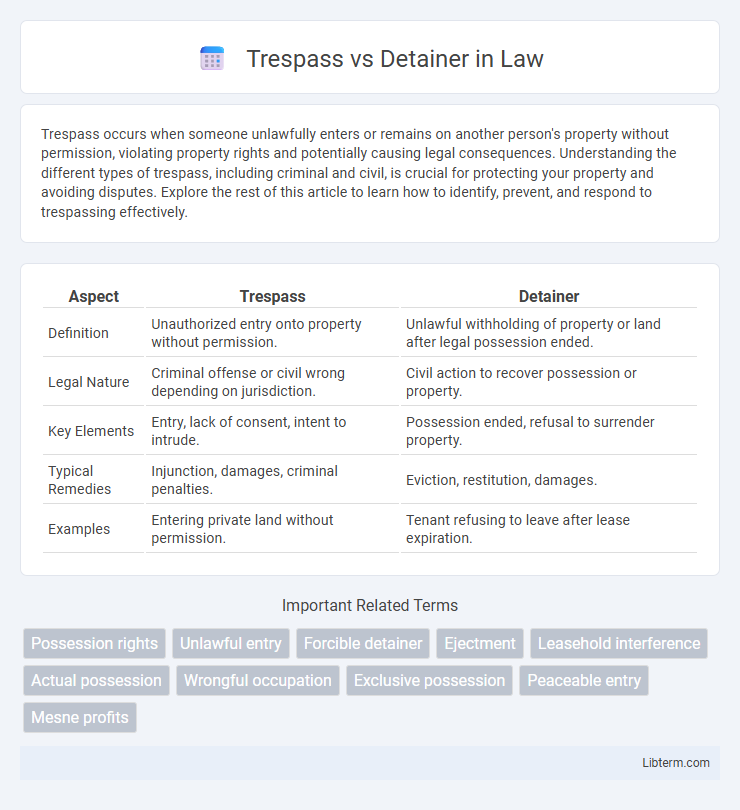Trespass occurs when someone unlawfully enters or remains on another person's property without permission, violating property rights and potentially causing legal consequences. Understanding the different types of trespass, including criminal and civil, is crucial for protecting your property and avoiding disputes. Explore the rest of this article to learn how to identify, prevent, and respond to trespassing effectively.
Table of Comparison
| Aspect | Trespass | Detainer |
|---|---|---|
| Definition | Unauthorized entry onto property without permission. | Unlawful withholding of property or land after legal possession ended. |
| Legal Nature | Criminal offense or civil wrong depending on jurisdiction. | Civil action to recover possession or property. |
| Key Elements | Entry, lack of consent, intent to intrude. | Possession ended, refusal to surrender property. |
| Typical Remedies | Injunction, damages, criminal penalties. | Eviction, restitution, damages. |
| Examples | Entering private land without permission. | Tenant refusing to leave after lease expiration. |
Understanding Trespass: Definition and Scope
Trespass involves unauthorized entry onto private property, violating the owner's exclusive rights and often resulting in civil liability or criminal charges. This action breaches legal boundaries by infringing on possession without the occupant's consent, including walking, driving, or placing objects on the property. Understanding trespass requires recognizing its scope covers both intentional and negligent intrusions, highlighting the protection of property rights under state laws.
What is Detainer? Key Legal Concepts
A detainer is a legal claim filed by a landlord to regain possession of a property when a tenant remains after the lease term expires or violates the lease terms. Key legal concepts of detainer involve the landlord's right to reclaim possession, the requirement of proper notice to the tenant, and the necessity of filing a formal eviction lawsuit in court. Understanding detainer helps differentiate it from trespass, as detainer pertains to occupancy based on prior lawful possession while trespass involves unauthorized entry without any legal right.
Trespass vs Detainer: Core Differences
Trespass involves entering or remaining on property without permission, often classified as a criminal offense, while detainer refers to the legal right to hold possession of property, typically after tenancy expiration. Trespass cases emphasize unauthorized physical presence and potential harm, whereas detainer actions focus on eviction procedures and property rights enforcement. Understanding the distinction clarifies the legal remedies available, with trespass involving criminal penalties and detainer addressing civil possession disputes.
Legal Consequences of Trespass
Trespass involves unlawfully entering or remaining on another person's property, leading to potential civil liability and criminal charges depending on jurisdiction. Legal consequences of trespass can include fines, damages for property harm, and possible imprisonment if the trespass is aggravated or involves intent to commit a crime. Courts often differentiate trespass from detainer, with trespass focused on unauthorized entry, while detainer deals with wrongful possession after lawful entry.
Legal Ramifications of Detainer
Detainer involves the unlawful holding of property or premises after the legal right to possess has expired, often triggering eviction proceedings under civil law. Legal ramifications of detainer include court-issued writs of possession, monetary damages for unlawful holding, and potential criminal penalties in certain jurisdictions. Understanding these consequences is critical for landlords enforcing lease terminations and tenants disputing possession claims.
Key Elements Required to Prove Trespass
Proving trespass requires establishing unauthorized entry onto the property of another person without consent. Key elements include demonstrating possession or lawful control of the premises by the plaintiff, an intentional and physical entry by the defendant, and lack of permission or legal right for the defendant to be on the property. Evidence often involves witness testimony, property boundary documentation, and proof of an exclusive possessory interest.
Establishing a Case for Detainer
Establishing a case for detainer requires proving the defendant's unlawful possession of property after the expiration of a lawful tenancy or lease agreement. The plaintiff must present documentation such as lease agreements, notices to vacate, and evidence of the tenant's failure to surrender possession upon termination of the tenancy. Courts typically require clear proof that the tenant has overstayed beyond the allowed period without permission, distinguishing detainer from trespass based on the initial lawful entry and tenancy relationship.
Defenses Against Trespass Claims
Defenses against trespass claims often include proving lawful entry, such as having consent from the property owner or a valid legal right like an easement. Another common defense is showing lack of intent to trespass, which may arise from mistaken property boundaries or emergency situations. Evidence that the property was not clearly marked or that the claimant waived their right to exclude can also mitigate trespass liability.
Defenses in Detainer Cases
Defenses in detainer cases commonly include improper service of the detainer notice, lack of legal standing by the landlord, and failure to comply with procedural eviction requirements under state law. Tenants may argue that the detainer action is retaliatory or discriminatory, which can invalidate the landlord's claim. Proving payment of rent or establishing the lease termination did not occur also serves as a critical defense against detainer judgments.
Choosing the Right Legal Action: Trespass or Detainer?
Choosing the right legal action between trespass and detainer depends on the nature of property possession and the circumstances of the dispute. Trespass suits address unauthorized entry or use of land, focusing on preventing or remedying unlawful intrusions. Detainer actions target the unlawful withholding of possession, aiming to recover property from someone who initially had rightful access but refuses to vacate.
Trespass Infographic

 libterm.com
libterm.com